Like the movie 2012, Tolkien's Lord of the Rings trilogy is another account of the shifting of the ages. Jay Weidner has written an excellent essay on Tolkien's knowledge of alchemy and world mythology. It shows how The Lord of the Rings itself
is the story of the passage from the Third Age, or the Age of Bronze, to
the Fourth Age, our own era -- the Age of Iron or the Kali Yuga.
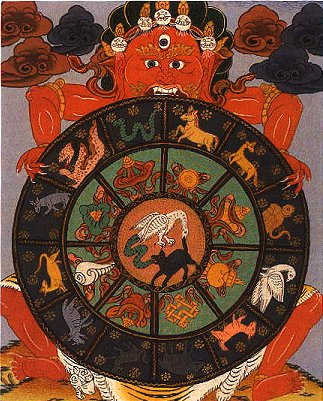
While the Third Age of Middle-earth formally came to a close with the downfall of Sauron and the passing of the Three Rings into the West, the beginning of its end was marked by the discovery of the One Ring by Bilbo.
Riddles of Darkness
Undoubtedly, the best scene of The Hobbit: An Unexpected Journey is exactly this moment when Bilbo finds the Ring. In fact, this is the only scene in the entire movie which utterly compelled me. Not only is it the best scene, but it is the most important event of the story which the film is telling. Clearly, if there is any deeper mystery to be unravelled in this Dec. 14th film, it is to be found here.
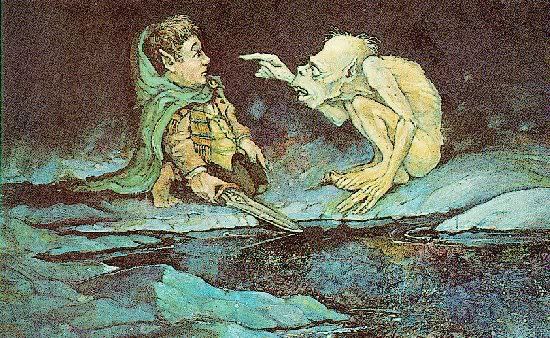
In the book, The Hobbit, this episode involves a riddling game between Bilbo and Gollum. The chapter is called "Riddles in the Dark."
His [Bilbo's] head was swimming, and he was far from certain even of the direction they had been going in when he had his fall. He guessed as well as he could, and crawled along for a good way, till suddenly his hand met what felt like a tiny ring of cold metal lying on the floor of the tunnel. It was a turning point in his career, but he did not know it. He put the ring in his pocket almost without thinking; certainly it did not seem of any particular use at the moment.
Within a short time of finding the Ring, Bilbo encounters Gollum and the game of riddles begins. The stakes are high: Bilbo would be shown the passage out if he won, and eaten if he lost.
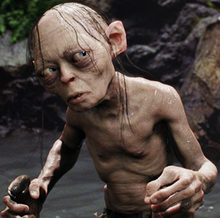
Gollum poses the first riddle:
What has roots as nobody sees,Mountain is the answer, and it is the mountain in which both Gollum and the Ring dwell. It is a place of darkness. Mountains "never grow," apparently, because they are not as quickly affected by time as living beings. From our perspective, mountains are nearly immortal. Bilbo is next:
Is taller than trees
Up, up it goes,
And yet never grows?
Thirty white horses on a red hill,The answer here is teeth, and while the riddle compares teeth to horses it is easy to envision teeth as a ring of mountains. Like bones, like mountains, teeth long survive the decomposition of the flesh after death. On a smaller scale than mountains, teeth also exist at a much slower pace of time. The subject of Gollum's riddle is grand and impersonal, and Bilbo's subject is smaller and more intimate, but both of these two will outlast us.
First they champ,
Then they stamp,
Then they stand still.

Voiceless it cries,Gollum's next riddle is the wind. It's interesting that it is described as being "toothless." The wind is even less affected by time than mountains and teeth. It is ever-present and is breathed in by all living creatures, but dependent on none of them. This riddle takes us even further into cold abstraction.
Wingless flutters,
Toothless bites,
Mouthless mutters.
In the film a couple riddles are skipped, which are worth returning to, but in his next riddle Bilbo attempts to steer the game back to the sunny, day-to-day world of breakfast and nourishment.
A box without hinges, key or lid,"Eggses!" Gollum hisses. This is correct, but I think that Tolkien might have something much bigger in mind.
Yet golden treasure inside is hid.

Blake's term for the entire fallen cosmos is the "mundane shell" -- our egg-shaped world of limited perception that is as comfortable as it is inauthentic. Like Bilbo's nostalgia for hearty breakfasts and easy living in the Shire, it is this shell that keeps us from fully exploring our own imagination, from realizing eternity. The mundane shell, the cosmic egg, is the cycle of time. It contains all cycles, including the very cycle of life.
Four other riddles are given in the book that are not depicted in the film. Bilbo's riddles about the sun shining on the daisies, and a man and his cat eating fish are both cheery, light-filled instances in the mundane cycle. Gollum, on the other hand, describes fish as being as "cold as death." His next riddle deserves a closer look:
It cannot be seen, cannot be felt,The solution is darkness, and while in the book Gollum poses this just before Bilbo's egg riddle it could also be taken as a response to it. What is beyond the mundane shell, beyond the stars? Darkness. It even permeates and fills the holes and empty gaps within this world. It is, in a sense, what the shell protects us from -- an infinitude of darkness. The shell is the "limit of opacity," as Blake called it. All the warm, hobbit-like pleasantries of this world can only be savoured if we are ignorant of, or suppress, the darkness. But it still there and will find us in the end.
Cannot be heard, cannot be smelt.
It lies behind stars and under hills,
And empty holes it fills.
It comes first and follows after,
Ends life, kills laughter.

Gollum's last riddle in the film continues along these lines:
This thing all things devours:Time itself finally enters into the game. We find that even the mountains are beaten down by it. Apparently nothing is greater than it. Toothless like the wind, it nonetheless devours everything. The mundane shell, which Bilbo describes as being sunny and abundant, is the same world that Gollum knows is filled with darkness and misery. Both characters are subject to time. One is temporarily in Fortune's favour, the other perhaps not. Gollum, though, seems the wiser for being the more afflicted.
Birds, beasts, trees, flowers;
Gnaws iron, bites steel;
Grinds hard stones to meal;
Slays king, ruins town,
And beats high mountain down.
Bilbo's final riddle, more of a stumbling question than a riddle, is really the riddle behind all of these riddles. His question is "What have I got in my pocket?" The answer is of course, although not even Gandalf knew positively until years later, the One Ring.

The words that appeared several decades afterwards when the Ring was thrown into Frodo's warm fire translate as:
One ring to rule them all, one ring to find them,The One Ring, forged centuries before, has the power to enslave all the other magical ruling rings of Elves, Dwarves and Men. All will be bound by it, and its Lord, in absolute darkness.
One ring to bring them all and in the darkness bind them.
The Golden Bind
It's remarkable, whether Tolkien intended this or not, that this inscription perfectly answers the riddles of The Hobbit. The Ring is both darkness and time, and all of the things like mountains and teeth and the lives of mortals which are eventually overcome by time. It is itself the binding Mundane Shell which is surrounded by darkness from one perspective. But from the viewpoint of those with perceptions cleansed, the Ring also represents that which binds us to this world of relative darkness. It prevents us from an experience of eternity.
In other words, the Ring is identical to Fortuna's Wheel. Power over it is power over everything -- both light and darkness, "good" and "bad." All is bound to the golden Wheel. In the preface to the Silmarillion, Tolkien appears to confirm this view of the Ring:
The chief power (of all the Rings alike) was the prevention or slowing of decay (i.e. 'change' viewed as a regrettable thing), the preservation of what is desired or loved, or its semblance. But also they enhanced the natural powers of a possessor thus approaching 'magic', a motive easily corruptible into evil, a lust for domination.
The power of the Ring is primarily a power over time or Fortune. With such a power, which is also the desire for immortality, comes the "lust for domination." In a previous post, I discussed how exactly this lust for immortality and domination among shamans and priests led to the creation of the State and its successive Empires of debt enslavement.
For Blake, this is the primary quality of this fallen world enclosed by the Mundane Shell. It is ruled by the Selfhood which in turn tries to subject all others. The archetypal figure most representative of the Selfhood is Satan. In a sense, then, the One Ring is Satan's ring. Satan is exactly Tolkien's model for Sauron and Sauron's master, Morgoth or Melkor.

To go deeper, though, this means that Satan is the lord of time, the Prince of this World. The Ring represents the complete Fall into time. As Weidner's essay demonstrates, Tolkien's mythology, following archaic and classical world mythology, is a vast epic of a successive and ever deeper Fall into matter and time. In this, he definitely aligns with Blake.
The recovery of the Ring, as told in The Hobbit, represents both a threat and a hope for Middle Earth. On one side, it signals that the Dark Power is now able to complete its total enslavement of the world. On the other side, it exposes this power for all to see. It reveals the Dark Power's greatest strength, but also its greatest weakness. The Ring shows that this power rests on its ability to manipulate our sense of time. Its recovery indicates that both sides are culminating at once.
The film's Dec. 14th release in the US, and the terrible events that coincided with it, can be viewed in this light. Satan's ring was recovered amidst the senseless slaughter of innocents. Can hope as well as fear be found here? Does this event signal an even deeper, perhaps total, enslavement by time and the reign of quantity? Does the Wheel of Fortune become fully unveiled as a Wheel of Torture, or is ultimate liberation at hand?

If the Ring was symbolically recovered on Dec. 14th, then it was first forged last July. During the Opening Ceremony of the London 2012 Olympics the One Ring was cast and raised to rule over the other four rings in front of an audience of millions.

In a previous post this ceremony was examined in depth. Danny Boyle, in his Finnegans Wake-like intertwining of all British history, literature and pop culture, included the ring-forging sequence in a section of the ceremony alluding to Blake's "Satanic mills." Boyle's name for this sequence, however, is "Pandaemonium," the capital city of John Milton's Paradise Lost. It is Milton who really ties together the work of Blake and Tolkien in regard to the Orc Cycle.
Fall From Splendour
In Tolkien's mythology it is Sauron who forges the Ring, but Sauron was the servant of an even darker lord, Morgoth or Melkor. Melkor was the most powerful of the Ainur, the old gods of Middle-earth. He was the original dark force who desired to pervert all of creation and dominate it with his will. With this desire, Melkor was the first to Fall:
From splendour he fell through arrogance to contempt for all things save himself, a spirit wasteful and pitiless. Understanding he turned to subtlety in perverting to his own will all that he would use, until he became a liar without shame. He began with the desire of the Light, but when he could not possess it for himself alone, he descended though fire and wrath into a great burning, down into Darkness. And darkness he used most in his evil works upon Arda (Earth) and filled it with fear for all living things. Silmarillion, p. 31.

Jay Weidner explains the mythic and archetypal similarity of Melkor to the Gnostic Demiurge:
So from the beginning of the actual formation of the earth out of the music and vision of the Gods the corruption of the Divine Art of Creation began. Having fallen from grace in a manner reminiscent of the Demiurge of the Christian Gnostics, Melkor could never create of his own accord but merely produce counterfeit versions of pre-existing beings by twisting, distorting and manipulating those created by the One. In this way, he brought forth a rift into the world. For from the moment that he 'fell' and turned his face towards egotism and tyranny, Melkor became an irritant that could not be ignored.
It is obvious, though, that Tolkien is referring to Satan as well. This version of Satan, however, comes more from Milton's Paradise Lost then it does from the Bible. In Blake's own writing, especially in The Marriage of Heaven and Hell and later in Milton, Blake points out Milton's heroic portrayal of Satan.
The reason Milton wrote in fetters when he wrote of Angels & God, and at liberty when of Devils & Hell, is because he was a true Poet and of the Devil’s party without knowing it.
--The Marriage of Heaven and Hell, plate 6.
Blake recognized in Milton's Satan the story of Orc -- the transformation of a Man to a Snake to a Dragon. Blake realized in his inversion of all conventional morality that Satan as Lucifer, at least initially, was a revolutionary would-be liberator. He sensed that Milton too realized this, but remained in his orthodox "fetters." In the beginning Satan rises up against the Demiurge, the Prince of this World, the God of the Old Testament, or Urizen himself. Only later does he truly Fall.

Satan, like all Orcs, becomes ensnared by his own Selfhood. He becomes seduced by power. He is seduced by the Ring of this Mundane Shell. He himself becomes the new Dark Lord of the fallen world. Tolkien does not dwell on this part of the myth, but it is essential to know if we are to understand Morgoth and then Sauron. They too are aspects of Orc.
Blake's exploration of the Orc Cycle is thus needed to complete both Milton and Tolkien. The Gnostics are basically correct. The God of this world is an evil Demiurge. It is the poetic brilliance of Blake to add that throughout history the potential usurpers of this Yaldabaoth in turn become cosmic tyrants.
You're Not My Father
In a sense, though, Blake is following a theme that is found continuously in global mythology. In Greek and Roman myth we read of the castration of the primordial sky-god, Uranus, by his son, Saturn.

Saturn or Kronos, although he was said to have ruled justly over a Golden Age, devoured his own children on hearing a prophecy that he would likewise be overthrown by one of them. Eventually, Jupiter or Zeus, hidden from Saturn, was able to do just this and to imprison his father in the underworld. Zeus himself existed in perpetual paranoia that the same fate would befall him. He was especially worried about his sons, Apollo and Dionysus.

These myths illustrate that even the gods are subject to the turnings of the Wheel of Fortune. It was Blake's unique genius to realize, though, and to express as art the idea that the main mechanism of Fortune, the whole loop of the Fall and Redemption, is built on the will to power. The Wheel of Fortune, governing the fate of both kings and paupers, is in essence the Orc cycle.
In modern times we see the Orc cycle play out in movies constantly. One very obvious example is the Star Wars series. Joseph Campbell's influence on George Lucas, and especially in Campbell's idea of the Hero's Journey, is well-known. As this "monomyth" was taken straight from Joyce, we could say that Star Wars indirectly derives from the pages of Finnegans Wake.
The Hero's Journey is really one half of the Orc Cycle. What we don't notice as much in the work of Campbell is how when the hero returns home, after killing the Dragon, saving the kingdom, etc., he soon begins to become a tyrant or Dragon himself. In the prequel trilogy to Star Wars, however, Lucas shows just this process.

An Unexpected Journey has often recently been compared to the first of these films, The Phantom Menace. Both are unpopular prequels to highly successful film trilogies, both are criticized for their over-use of special effects at the expense of good story-telling, and both featured ridiculous supporting roles -- the bunny-sled riding, birdshit streaked wizard, Radagast, and the cosmic, floppy-headed, underwater-living rasta, Jar Jar Binks.
A more relevant comparison here, however, is that both films depict a time of apparent growing darkness. The Phantom Menace and the two following films, much more clearly than An Unexpected Journey, are the story of how a revolutionary Orc becomes a tyrant himself. Anakin Skywalker morphs into Darth Vader. The Republic becomes an Empire.

An Unexpected Journey marks this rise of darkness with the recovery of the Ring. Sauron knows that if he regains this Ring he will become invincible. As noted previously, the significance of symbolically finding the Ring on Dec. 14th points to a similar rise in darkness, to yet another Orc cycle.
Antiorc
The alleged shooter of Sandy Hook, Adam Lanza, and other shooters of the recent past, such as Jared Lee Loughner, Anders Behring Breivik and James Holmes, might also be classed as Orcs and/or orcs.
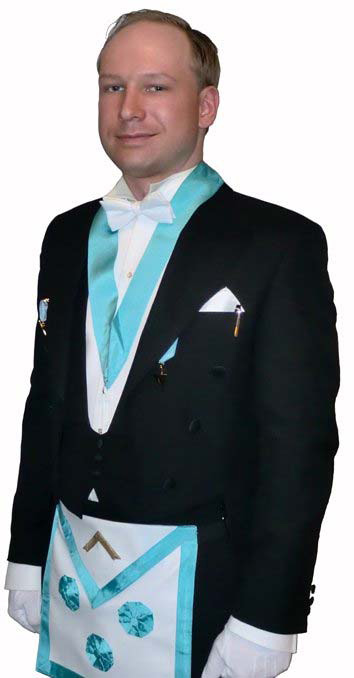
It could be that all of these men, although it is dangerous to attribute reason to obvious psychosis, saw themselves as revolutionaries -- Breivik certainly did. It could be that they thought that their actions, horrendous in themselves, would eventually provoke radical change that would overturn the old, corrupt order. This is the thinking of Orc.
An earlier yet related figure, Charles Manson, also thought in similar terms. Manson convinced his followers that their actions would provoke a Race War which would quickly escalate into a general Apocalypse and hence a New World. And, as writer Peter Levenda in Sinister Forces recounts, Manson, the Son of Man, had himself crucified while on LSD in 1968:
Charlie decided to re-enact the Crucifixion with himself as the central character. He dropped acid. His followers tied him to a cross, jeered and humiliated him, and then symbolically killed him. They later celebrated his resurrection with an act of group sex.
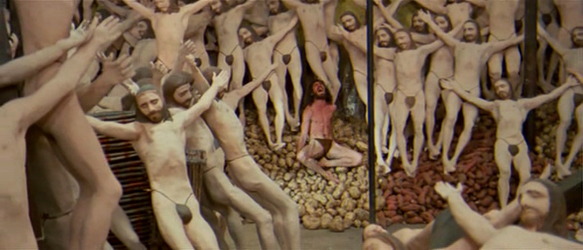
Whether or not this is entirely accurate, the myth does help to peg Manson as an Orc figure. The crucifixion of Orc is a key aspect of Blake's poetic cycle. The name Adam Lanza also resonates here. Both Adam and Lanza correspond to different "Eyes of God" or "historic" Orc cycles. Adam obviously is the first man, while Lanza recalls the second Adam -- Christ who was pierced by a lance while on the cross.

None of this is meant to glorify these individuals or the atrocities attributed to them. It is necessary, though, to realize the ambiguous nature of Orc. It is possible that these figures really believed that they had a role to play in the overturning of the old order.
In this, they did not succeed and they became corrupted by the very actions that they had hoped would trigger the change. They are Lucifers who almost immediately became Satan. But in terms of the vast cycles of the Seven Eyes of God they are small Orcs.
In a sense, they are also false Orcs. They were never intended to accomplish anything beyond making the system stronger, to keep the cycle turning. In lieu of a real revolutionary Orc archetype, these surrogate Orcs or orcs allow the current Urizen to tighten his grip on power.
There are also times when Urizen poses as Orc. Things become so bad that the people demand an Orc to change everything. When this "Orc" comes to power he quickly shows his true colours. Only the most deluded believers of the hope and change promised still think that he was ever a genuine Orc at all. At best he is Dragon in the guise of a Snake.

And so the cycle continues.
The Stumbling Block
More and more people are beginning to question the Official Story of Sandy Hook. Videos and articles questioning this story have gone super-viral. Whatever merits there are in these speculations, it is truly significant that a level and raw mass of doubt that took years to show its head after 9/11 has manifested in just over a month after this event.
One can without effort construct a very paranoid, meta-conspiracy theory on why this is happening. Free and privileged US citizens, like Roman citizens of old, are the last stumbling block to total NWO imperial takeover. They are akin to Iraq, Libya and all of the other so-called "rogue states." They are too independent, too spoiled, and too opposed to being dominated by the imperial will. They have become increasingly docile and obedient over the last decade, but they must have their spirits completely crushed.
The Empire knows that the only true Orc it needs to fear is if the most anti-authoritarian, liberty-loving elements of movements similar to both the Tea Party and Occupy unite against it. If a genuine union of resistance like this occurred the masses would quickly join it.

To prevent this, the Empire hammers in the ultimate wedge -- a call for gun control in response to the massacre of children.
The meta-conspiracy theory mulls overs the possibility that the goal of this operation is not simply to disarm Americans, but to provoke Civil War. Why was Alex Jones able to rant like a madman against gun control and for a new American revolution on CNN? Because the Empire knew that he would repulse and disgust half of the US population. He might even inspire the other half. Even better.
A dystopic scenario is easy to envision. The government attempts to forcibly take away the people's guns and is violently resisted. Resistance spreads and becomes amplified. Chaos ensues. Divisions of the military refuse to fire on the rebels. The US becomes dangerously close to becoming a failed state with nukes and the UN agrees to send in troops. The rebellion is quashed and a World Government is declared. A boot stomping on a human face forever.

If such a thing is on the Agenda, it's equally easy to think of reasons why it wouldn't work. If anything, it is only one scenario among many being considered. It's obvious, though, that the world, and particularly US society, is facing a multifaceted, unprecedented crisis. Revolution and/or Civil War are not out of the question.
In the US, the clamour for one or both of these is becoming louder every day. It is remarkable that the banner from which Blake may have got the association of the Snake symbol for the revolutionary Orc is now, once again, the flag of American anti-government rebels. The Serpent rises again.

Reaping the Stars
While Blake initially supported the revolutions in both America and France, his vision of change goes far beyond even the most radical revolutionaries of his or any other time in history. He hoped that the 19th century revolutions would go global, eliminate tyranny and injustice from all lands, provoke the Apocalypse, and eventually bring about an entirely new, unfallen Creation (notice the similarities and differences to Manson). Northrop Frye explains Blake's radical position:
Thus when the fall of the Bastille aroused a wave of enthusiasm in England, Blake turned at once to write an epic on the French Revolution, in which he treated this event sub species aeternitatis as the beginning of the end of the long nightmare of cruelty and injustice which is human history.
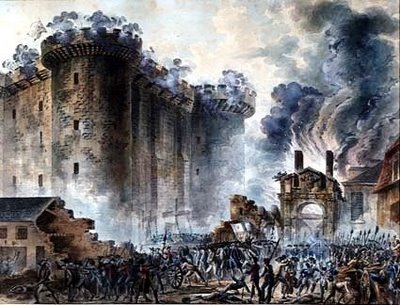
The desire to end the long nightmare of history recalls Stephen Dedalus' words from Ulysses -- "History is a nightmare from which I am trying to awake." To awaken from the nightmare of history is to finally end the Orc cycle. It is to pass from revolution to revelation.
The "starry harvest" of six thousand years, Blake's conventional figure for the interval between creation and apocalypse, is about to be reaped: men are about to unite into a single Man, who is God, and who will dwell in a new heaven and a new earth. The fall of the French monarchy, like the fall of empires in the prophecies of the Bible, is significant only as a sign of an approaching Messianic kingdom of liberty.
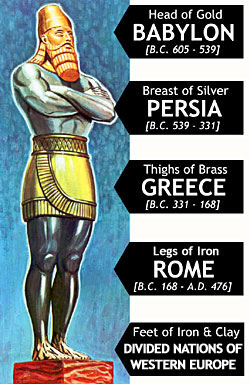
Blake, and Joyce following him, aims for nothing less than the collapse of all empires including, at a very fundamental level, the Black Iron Prison of the Demiurge, Melkor/Urizen/Satan/Zeus/Jehovah, himself. Blake desires the breaking of the Wheel -- the starry harvest -- and the mass reawakening into eternity.
For many, this was the promise of December 21st, 2012. The final empire was about to decisively and catastrophically reach its breaking point. Things were about to approach such a level of weirdness that any sort of control would be impossible. Time would end.
The point in the cyclic epics of Tolkien and Lucas most comparable to the expectations for 2012, is their presentation of the explosive climax at the end of the age. In The Return of the King, this is depicted in the fall and collapse of Barad-dûr. In The Return of the Jedi, this is the death of the Emperor and the destruction of the Death Star. 2012 was to have ended in cleansing fire. A cosmic ekpyrosis.
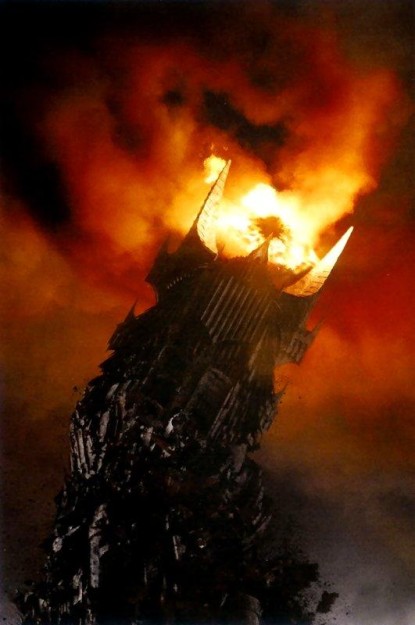

When nothing like this happened many of us, perhaps more privately than publicly, began to scratch our heads. Were the debunkers right in the end? Were all of the prophecies and visions, including those of Terence McKenna, utter bullshit?
Could it be, though, that 12/21/12 did happen as foreseen, but we were wrong about where things are in the cycle? The Ring was found on Dec. 14th, in the midst of all of the highly charged events of that day, but it has not yet been destroyed. Before being destroyed the Ring must first be revealed. This is the revelation. This is the apocalypse. But what is the Ring?
As discussed above, the Ring is the Wheel of Fortune itself. To reveal the Ring is to reveal the illusory nature of time and all that rests on this illusion. To finally shatter these illusions is to cast the Ring into fiery oblivion, it is to break the cycle and to reenter eternity.
Nope
ReplyDeleteNope what?
Delete